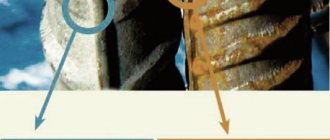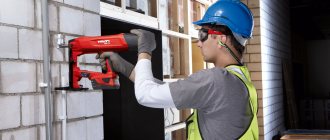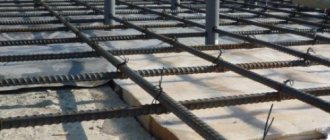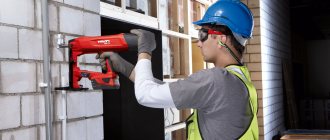Before pouring concrete, a procedure called concrete reinforcement is usually performed. First, a frame structure is created based on long metal rods - then this structure is filled with liquid concrete. During installation of the frame structure, it is necessary to fasten the metal rods together to make the structure more durable and reliable. A rebar tying gun is often used to fasten rods. But what technical features does a rebar tying gun have? What types of knitting guns are there? How to store them correctly?
Work specifics
Externally, the instrument is a fairly compact device that weighs a little more than 4 kg.
The main components of the pistol are:
- Case with mechanism.
- Cutting mechanism.
- Handle with start button.
- Wire feed mechanism.
- Working part.
- Electric drive device
- Reel holder.
- Wire cassette.
Expert opinion
Torsunov Pavel Maksimovich
The specific operation of the knitting device is quite simple: wire is fed from a reel, a loop is formed at the intersection of the reinforcing bars, tightened, and then the wire is automatically cut off.
Kinds
Depending on the operating conditions, two types of devices are used:
- Cordless mating gun
Its main advantage is that it can provide uninterrupted work in areas without power supply. This device has a particularly powerful battery, and the length of the wire is enough to work for an entire shift.
- Mechanical mating gun
Usually produced with a replaceable wire cassette included. The characteristics of such a device directly depend on what brand it is and the size of the reinforcing bars. It will be possible to work on the frame with such a gun only after special training.
Design Features
According to their design, all knitting guns are divided into two large groups:
- Mechanical
- Electrical
Among the mechanical ones, the most popular is the Wacker device produced under the marking DF-16. It is distinguished by speed and mobility comparable to electric models. It has attachments that expand its use (for knitting horizontal surfaces). The DF-16 has only two disadvantages:
- dimensions (it is almost three times longer than the electric one),
- the difficulty of filling with special metal brackets.
All electric models differ in the method of knitting:
- By repeatedly wrapping the wire around the reinforcement
- Bending the wire in a C-shape and then twisting its ends
Both types of design use an electric motor powered by a battery. He pulls the wire from the drum (spool) along the guide protrusions and forms a bundle. After this, the wire is cut with a special knife and twisted with a preset force.
All described actions take from 1 to 2 seconds .
Power supplies and wire spools are quick-changeable. Replacing them takes no more than 30 seconds . One coil of wire allows you to form at least 200 knots on the reinforcement. The charge of one battery is enough to form 3,000 nodes .
What are the differences between a professional instrument and a simple one?
Characteristics of a professional gun for tying reinforcement:
- The wire diameter for such equipment varies from 0.8 mm to 1.5 mm.
- Efficiency of tying reinforcing bars . Powerful models spend no more than a couple of seconds on this.
- Ergonomics – for more convenient operation, pistols are equipped with retractable handles up to 20 cm in length.
- The weight of the device - this directly determines how long it can be used.
Also, the differences between pistols of different brands include greater or lesser battery capacity, warranties and service provided by the manufacturer.
Which technology is better - the advantages of knitting for reinforcement
Knitting wire for reinforcement is the optimal solution to ensure the strength of the reinforcement frame. Professionals involved in laying foundations, manufacturing reinforced concrete products and reinforced structures confidently claim that tying reinforcement using a special gun has a set of advantages compared to other methods.
Main advantages:
- increased reliability of fixation of reinforcing bars;
- durability of assembled metal structures;
- accelerated pace of assembly of reinforcement cages.
Thanks to the use of an automatic gun, which ensures improved quality of connections, the technology of fixing rods with wire provides the necessary performance characteristics and the advantages of a knitted connection.
The device is simple to operate, but significantly speeds up the frame manufacturing process
Why should you choose such a device?
A professional tool is the key to a high-quality result that will last for many years.
The main advantages of using a knitting gun are:
- High quality wire knots.
- Operative pace of work.
- Easy replacement of wire cassettes.
- Scope of work – 1 person can do the work for a small team.
- Fairly light weight.
- Possibility of knitting multi-layer knots.
- Adjusting the stretch marks makes the frame more durable.
- Pull tightly.
- Continuity of work during the shift due to a powerful battery.
Expert opinion
Torsunov Pavel Maksimovich
Of course, any tool also has its drawbacks. In particular, for a knitting gun this is a high price, the need to spend money on wire cassettes and inconvenience when working in cramped conditions.
General characteristics
During various construction works, reinforcement of structures is usually carried out using separate reinforcement bars. Frames are created by welding or bonded joints. It is possible to build structures from ready-made meshes, however, this practice is rarely used due to the complexity of the shapes. Thanks to the flexibility provided by individual rods, frames can be created on site to the desired shape. An excellent device that can speed up the tying of reinforcement is a special gun. It is quite easy to use and has many advantages.
Using a knitting gun, a knot is formed in 1-2 seconds.
Whereas a professional welder spends about 5-6 seconds on tying one assembly of reinforcement (provided that there are no obstacles on the way to the rod and the distance from the device to the frame is optimal so as not to change the usual working position). Compared to welding, reinforcement using a gun gives greater productivity. In addition, to work with this tool you do not need constant access to the electrical network; it is enough to periodically charge the battery. Gas equipment, which is usually necessary for the operation of the welding machine, will not be needed. Using a knitting gun is so easy that you don’t need any special skills.
The advantages of using a gun for knitting reinforcement include the following.
- Excellent quality of the resulting knots, due to the uniform tightening force.
- Increased labor productivity achieved by reducing the time spent on each rebar assembly.
- Thanks to the purchase of the tool, the employer can reduce the number of employees hired and benefit.
- The gun allows you to adjust the tension force of the unit , which increases its reliability.
- It is very convenient to work with the tool , since only one hand is used. If the reinforcing mesh is lying on the floor, the extension device will allow you to maintain a standing position while working, thereby reducing the load on your back.
- A capacious battery helps you work for a long time without recharging. Under certain conditions, the battery lasts for the entire shift.
- Safety.
Light weight and compact dimensions will help to knit in hard-to-reach corners of the frame. The disadvantages include the high cost of the device and the need to additionally purchase special wire.
However, if a construction organization has received an order for a large volume of frames made of reinforcement, then the knitting gun will quickly pay for itself.
For domestic purposes, the use of an expensive specialized knitting machine is not economically feasible.
How to choose a good tool?
First you need to decide what type of device is required - mechanical or battery-powered. If the work will be carried out exclusively for household purposes, then users are advised to purchase a mechanical gun, since a battery-powered one will be much more expensive.
Next, we choose which manufacturer is best to purchase the tool from. Builders praise the Japanese, but not everyone can afford the price they ask for their products. German and Korean equipment is considered a little less effective; they cost a little less. The domestic manufacturer also produces knitting guns at a very affordable price.
According to the characteristics, the tool can be divided into three types:
- Universal - work with reinforcement from 4 to 68 mm, wire with a diameter of 1.5 mm is required;
- Guns for binding reinforcement from 4 to 40 mm. They work with wire with a diameter of 0.8 mm and knit in three turns;
- Finally, those that work with reinforcement bars from 4 to 28 mm use the same 0.8 mm wire and make 2-3 turns.
For different types, the price will be appropriate. They will ask for much more for the first than for the third. But you need to approach the choice based on the required amount of work.
Do not buy “non-native” equipment for the equipment. If you have a German pistol, buy only German ones. It’s also not a good idea to manually wind the wire onto a reel - this will make the equipment last much less than it could.
Rules for using devices
Rebar tying guns can be electric or mechanical. The rules for using each tool are slightly different.
Electric models
When working with an electric tool for tying reinforcement, you must adhere to the following rules:
Electric gun for tying reinforcement
- Reinforcing bars are laid on a suitable surface in the form of grids.
- Use a wire brush to remove traces of rust. Any distortions are removed with a hammer.
- Before work, check whether the battery is sufficiently charged.
- A suitable wire for knitting is inserted into the spool.
- The length of the cut is adjusted according to the limb.
- The number of turns for each node is set.
- The knitting device is pressed tightly to the place where the knitting is performed. The button is pressed, after which a loop is thrown onto the reinforcement.
- Metal rods are quickly covered with wire, after which it is cut off and you can move on to the next connection.
Mechanical models
Working with a mechanical gun for tying reinforcement requires certain skills and physical preparation:
- The device is installed vertically. It must be perpendicular to the reinforcement.
- Lightly press the rod so that the wire just wraps around the connection.
- Little by little the rod is pulled up. This will allow the bracket to twist onto the crosshairs.
- The tool continues to be pulled until automatic release occurs.
Tying reinforcement with a mechanical gun
General rules for the operation of such equipment
When purchasing a gun for tying reinforcement, you must fulfill a number of requirements that will increase the efficiency of its operation:
- For rechargeable devices, you need to purchase spare batteries, and for network devices, extension cords;
- the instrument must be kept clean at all times;
- when performing mating, it is necessary to use personal protective equipment - gloves, glasses, clothing;
- when using a mechanical device, it is necessary to constantly lubricate and wipe the screw rod;
- You must always comply with the operating conditions specified by the manufacturer in the instructions.
Top best models
Firecore, 12 V, 1500 mAh
- Plus: high binding speed.
- Cons : none found.
Grost RT 308 C
- Plus: easy knitting of reinforcement.
- Cons: none found.
Egor: “Before using a new coil from the components, I sand it down. After this, the feed goes smoothly, the reel does not bite.”
Firecore, 12 V, 3000 mAh
- Plus: 2 batteries included.
- Cons: Not found.
Tips for using a knitting gun
Buying or renting this tool is expensive, and in order not to waste money, you need to follow the operating rules.
In the case of this device it is:
- Full charge of the battery, compliance of the wire and reinforcing bars with the parameters and “original” components. It is recommended to be especially careful when using components from Japanese brands; such a tool can easily be broken by using, for example, Chinese wire. Plus, such a breakdown is not included in the warranty agreement.
- It is also recommended to use extensions to form grating units if work is carried out with large horizontal frames. This will make the work much easier.
- Even though the operator can do more work with a knitting gun, an assistant is still needed.
What gun do you use for tying reinforcement?
BatteryMechanical
Tying reinforcement is the optimal method of fixing reinforcement cage bars
Building structures and products made of reinforced concrete are characterized by increased reliability and a long service life. The concrete mass retains its integrity under the influence of compressive loads and has an increased margin of safety due to the reinforcement frame. The spatial structure of reinforcing bars dampens tensile forces and torques, evenly distributing loads within the array. The frame prevents cracking provided that the reinforcing bars are securely fixed.
Reinforcement of structures on a construction site occurs, as a rule, using individual reinforcement bars
They are connected using various methods:
- using a welding machine designed for contact or arc welding. When spot welding, rods with a diameter of up to 2.4 cm are used, and electric arc welding allows you to fix rods of increased diameter. The electric welding method of fixing reinforcing bars allows you to quickly connect the joints of the rods. However, despite these advantages, the welding method has disadvantages. The main disadvantage is the disruption of the metal structure when heated, which negatively affects the properties of the material and the strength of the frame under load. In addition, welding zones are susceptible to corrosion, which reduces the reliability of the connection and shortens the service life. The increased rigidity of welded joints complicates the process of shrinkage and thermal deformation, increasing the likelihood of crack formation;
- using fixing clamps made of flexible plastic. When fixing reinforcing bars, labor productivity increases, since the joining process is simple - just manually wrap the joint area with a plastic clamp and pull it by the free end. The use of plastic joints significantly reduces the duration of knitting work. However, the technology has weaknesses. Elastic, at positive temperatures, plastic becomes brittle and loses strength in winter. As a result, the fixation strength of individual zones of the frame decreases, and the likelihood of violating the integrity of the clamps when workers move along the reinforcement frame increases. In addition, under the influence of loads created by vibrators for compacting concrete, the clamps weaken and burst;
- using a knitting gun that feeds the wire. The method of fastening the joint sections of the frame with annealed wire is simple, ensures reliable connection and a long period of operation of metal structures. When using a gun, labor productivity increases significantly compared to the manual knitting method using a crochet hook or semi-automatic device. The assembly of the reinforcement cage is carried out by connecting the intersections of the reinforcement with a special wire. It has spring properties and provides a limited degree of freedom to the assembled lattice, preserving the integrity of the metal structure. Using a mechanical knitting tool, the rebar knitter quickly assembles the rebar cage.
The rods provide flexibility, allowing any desired frame shape to be assembled on site
Each method of tying reinforcement has its own advantages and disadvantages. But if you need to make a reliable spatial lattice in a limited time, you cannot do without using a knitting gun.











